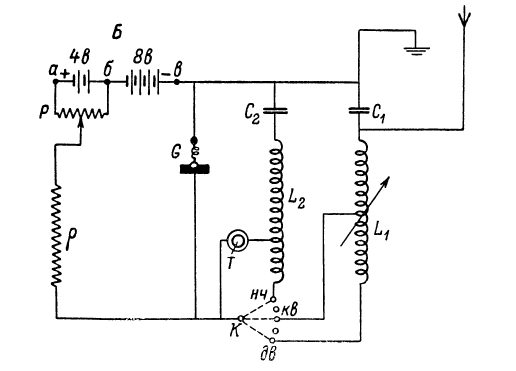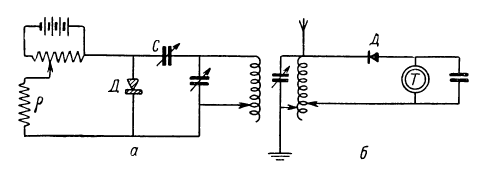
The number 8 of Radio Amateur magazine for 1924 was dedicated to Losev's "cristadine". The word “cristadine” was composed of the words “crystal” and “local oscillator”, and the “cristadine effect” was that when a negative bias was applied to the crystal of zincite (ZnO), the crystal began to generate undamped oscillations.
There was no theoretical justification for the effect. Losev himself believed that the effect is due to the presence of a microscopic "voltaic arc" at the point of contact of the zincite crystal with the steel wire.
The discovery of the "cristadine effect" opened up exciting prospects in radio engineering ...
... but it turned out as always ...
In 1922, Losev demonstrated the results of his research on the use of a crystalline detector as a generator of undamped oscillations. The publication on the topic of the report shows laboratory test schemes and a mathematical apparatus for processing research material. Let me remind you that Oleg at that time was not yet 19 years old.

The figure shows the test circuit of "cristadine" and its "N-shaped" current-voltage characteristic, typical of tunnel diodes. That Oleg Vladimirovich Losev was the first to apply the tunnel effect in semiconductors in practice, it became clear only after the war. This is not to say that in modern circuitry tunnel diodes are widely used, but a number of solutions to them successfully work on microwave.
A new breakthrough in radio electronics did not happen: then all the forces of the industry were then devoted to improving radio tubes. Radio tubes successfully supplanted electric cars and arc arresters from transmitting radio equipment. Lamp radios worked more steadily and became cheaper. Therefore, by professional radio technicians, “cristadine” was then considered as a curiosity: a heterodyne receiver without a lamp, you have to!
For radio amateurs, the design of the cristadine turned out to be complicated: a battery was required to supply bias voltage to the crystal, a potentiometer was required to set the bias, and another coil was required to search for crystal generating points.

In the NRL, the radio amateur difficulties were well understood, therefore, they published a brochure where the design of the cristadine and the design of the Shaposhnikov receiver were published together. First, radio amateurs made Shaposhnikov’s receiver, and then supplemented it with “cristadine” as a radio signal amplifier or local oscillator.
Bit of theory
At the time of the publication of the Cristadin design, all types of radios already existed:
1. Detector radios, including direct amplification receivers.
2. Heterodyne radio receivers (also known as direct conversion receivers).
3. Superheterodyne radio receivers.
4. Regenerative radios, incl. “Autodyne” and “synchrodine”.
The simplest of the radios was and remains a detector:

The detector receiver operates extremely simply: when a negative carrier half-wave is selected on the L1C1 circuit, the resistance of the detector VD1 remains high, and when it is positive, it decreases, i.e. detector VD1 “opens”. When receiving amplitude-modulated signals (AM) with the “open” detector VD1, the blocking capacitor C2 is charged, which is discharged through the BF telephones after the detector is “closed”.

The graphs depict the process of demodulating the AM signal in the detector receivers.
The disadvantages of the detector radio are obvious from the description of the principle of its action: it is not able to receive a signal whose power is not enough to “open” the detector.
To increase the sensitivity, “self-induction” coils wound “turn to turn” on large-diameter cardboard sleeves with a thick copper wire were actively used in the input resonant circuits of the detector receivers. Such inductors have a high quality factor, i.e. the ratio of reactance to active. This made it possible, when tuning the circuit to resonance, to increase the emf of the received radio signal.
Another way to increase the sensitivity of the detector radio is to use a local oscillator: the signal of the generator tuned to the carrier frequency is “mixed” into the input circuit of the receiver. In this case, the detector “opens” not with a weak carrier signal, but with a powerful generator signal. The heterodyne reception was opened even before the invention of radio tubes and crystal detectors and is still in use.

“Kristadin” used as a local oscillator is indicated in the figure by the letter “a”, the letter “b” denotes a conventional detector receiver.
A significant drawback of the local oscillator reception was the whistle arising due to the "beats of frequencies" of the local oscillator and the carrier. This “drawback”, by the way, was actively used to receive “by ear” a radio telegraph (CW), when the receiver local oscillator was tuned in frequency from 600 to 800 Hz from the transmitter frequency and when the key was pressed, a tone signal appeared in the phones.
Another disadvantage of heterodyne reception was the noticeable periodic “attenuation” of the signal when the frequencies coincided, but the phases of the local oscillator and the carrier did not coincide. Regenerative tube radio receivers (Reinartz receivers), which reigned supreme in the mid-1920s, were deprived of this disadvantage. With them, too, everything was not easy, but that's another story ...
About "superheterodynes" it is necessary to mention that it became economically feasible to produce them only from the middle of the 30s. Currently, “superheterodynes” are still widely used (unlike “regenerators” and “detectors”), but are actively replaced by heterodyne devices with software signal processing (SDR).
Who is Mr Lossev?
The story of the appearance of Oleg Losev in the Nizhny Novgorod radio laboratory began back in Tver, where after listening to a lecture by the head of the Tver radio reception station, staff captain Leshchinsky, the young man lights up the radio.
After graduating from a real school, the young man goes to enter the Moscow Institute of Communications, but somehow arrives in Nizhny Novgorod and tries to get a job in the NRL, where he is taken by courier. There is not enough money, you have to sleep in the NRL on the landing, but this is not an obstacle for Oleg. He conducts research on physical processes in crystalline detectors.
Colleagues believed that prof. Prof. VC. Lebedinsky, whom he met back in Tver. The professor singled out Losev and liked to talk with him on research topics. Vladimir Konstantinovich was invariably benevolent, considerate and gave a lot of advice disguised as questions.
Oleg Vladimirovich Losev devoted his whole life to science. Preferred to work alone. Published without co-authors. I was not happy in marriage. In 1928 he moved to Leningrad. He worked at the TsRL. Worked with ac. Joffe. Became Ph.D. "By the totality of work." He died in 1942 in the besieged Leningrad.
From the collection "Nizhny Novgorod Pioneers of Soviet Radio Engineering" about Losev's "cristadins":
Oleg Vladimirovich’s research in its content was initially technical and even amateur in nature, but it was precisely with them that he won world fame by discovering in a detector made of zincite (mineral zinc oxide) with a steel tip the ability to excite undamped oscillations in radio circuits. This principle formed the basis of a tubeless radio with amplification of a signal having the properties of a tube. In 1922, he was called “cristadine” (crystalline heterodyne) abroad.
Not limited to the discovery of this phenomenon and the design of the receiver, the author develops a method for artificially refinement of second-class zincite crystals (by remelting them in an electric arc), and also seeks a simplified way of finding active points on the crystal surface for touching the tip, which provided vibration excitation.
The tasks that arose in this case did not have a trivial solution; it was necessary to conduct research in the still undeveloped areas of physics; amateur radio failures stimulated physical research. It was physics completely applied. The simplest explanation of the phenomenon of oscillation generation, which then emerged, was its connection with the thermal coefficient of resistance of the zincite detector, which, as expected, turned out to be negative.
Used sources:
1. Losev OV At the origins of semiconductor technology. Selected Works - L .: Nauka, 1972
2. "Radio amateur", 1924, No. 8
3. Ostroumov B.A. Nizhny Novgorod pioneers of Soviet radio engineering - L .: Nauka, 1966
4. www.museum.unn.ru/managfs/index.phtml?id=13
5. Polyakov V.T. Radio technique. Simple receivers of AM signals - M .: DMK Press, 2001